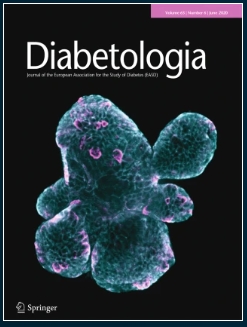人类成人胰腺组织学的定量分析揭示了2型糖尿病中不同的脂肪和纤维化表型。
IF 10.2
1区 医学
Q1 ENDOCRINOLOGY & METABOLISM
引用次数: 0
摘要
目的/假设胰内脂质和胶原蛋白在2型糖尿病发病机制中的作用尚不清楚。我们试图在患有和不患有糖尿病的器官捐献者的胰腺中检查这一点。方法从16个解剖区收集36例有/无2型糖尿病的成人供体胰腺组织活检,进行H&E、Sirius Red、Fast Green和chromogranin A免疫组化染色和定量。用透射电镜定量测定腺泡、胰岛内分泌细胞的细胞内脂滴面积,用超微结构形态学鉴定β细胞和α细胞。结果脂肪细胞比例面积增加与胰腺供体BMI增加相关(r=0.385, p=0.021),腺泡面积减少(r=-0.762, p= 40%比例面积)形成两个独立的亚组。所有接受胰岛素治疗的糖尿病供者胶原蛋白比例面积均较高。纤维化而非脂肪增生与β: α细胞比值降低有关。胰腺脂肪增多与腺泡内细胞脂质含量呈负相关(r=-0.490, p=0.003), 2型糖尿病患者脂肪含量最低。β细胞脂质含量与BMI有关,但与2型糖尿病无关。结论/解释:系统的人类胰腺分析揭示了两种不同的2型糖尿病表型:脂肪型,与中心性肥胖相关;纤维化,与细胞数量减少有关,但没有中心肥胖。这表明了不同的潜在致病机制,并有可能开发个体化的疾病改善疗法。本文章由计算机程序翻译,如有差异,请以英文原文为准。
Quantitative analysis of human adult pancreatic histology reveals separate fatty and fibrotic phenotypes in type 2 diabetes.
AIMS/HYPOTHESIS
The role of intra-pancreatic lipid and collagen in type 2 diabetes pathogenesis remains unclear. We sought to examine this in pancreases from organ donors with and without diabetes.
METHODS
Tissue biopsies from 36 adult donor pancreases with/without type 2 diabetes were collected from 16 anatomically defined regions, with H&E, Sirius Red Fast Green and chromogranin A immunohistochemical staining and quantification performed. Intracellular lipid droplet area was quantified using transmission electron microscopy in acinar, islet endocrine, beta and alpha cells identified through ultrastructural morphology.
RESULTS
Increasing adipocyte proportional area was associated with increasing pancreas donor BMI (r=0.385, p=0.021), decreased acinar area (r=-0.762, p<0.001) and increased endocrine mass (r=0.749, p<0.001). Fibrosis was not associated with BMI, acinar area or endocrine mass. Type 2 diabetes was associated with decreased islet circularity and reduced beta:alpha cell ratio but endocrine mass was not affected. Adipocyte and fibrosis proportional areas were highest in donors with diabetes but not associated with each other. Pancreases with high fat and those with high fibrosis (>40% proportional area) appeared to form two separate subgroups. All donors with insulin-treated diabetes had a high collagen proportional area. Fibrosis but not adipocytosis was associated with decreased beta:alpha cell ratio. There was an inverse relationship between pancreatic adipocytosis and intra-acinar cell lipid content (r=-0.490, p=0.003), with the lowest levels seen in type 2 diabetes. Beta cell lipid content was associated with BMI but not type 2 diabetes.
CONCLUSIONS/INTERPRETATION
Systematic human pancreatic analysis revealed two separate type 2 diabetes phenotypes: fatty, associated with central obesity; and fibrotic, associated with reduced beta cell mass without central obesity. This suggests distinct underlying pathogenic mechanisms and has potential for developing personalised disease-modifying therapeutics.
求助全文
通过发布文献求助,成功后即可免费获取论文全文。
去求助
来源期刊

Diabetologia
医学-内分泌学与代谢
CiteScore
18.10
自引率
2.40%
发文量
193
审稿时长
1 months
期刊介绍:
Diabetologia, the authoritative journal dedicated to diabetes research, holds high visibility through society membership, libraries, and social media. As the official journal of the European Association for the Study of Diabetes, it is ranked in the top quartile of the 2019 JCR Impact Factors in the Endocrinology & Metabolism category. The journal boasts dedicated and expert editorial teams committed to supporting authors throughout the peer review process.
 求助内容:
求助内容: 应助结果提醒方式:
应助结果提醒方式:


